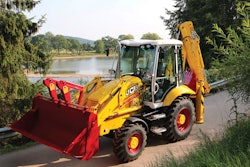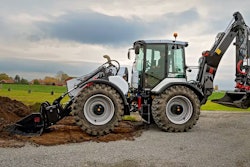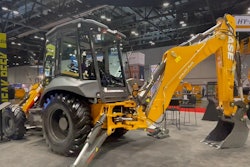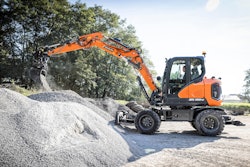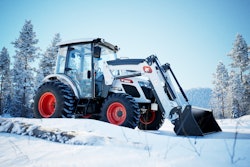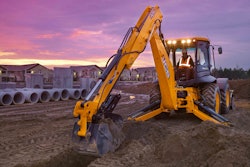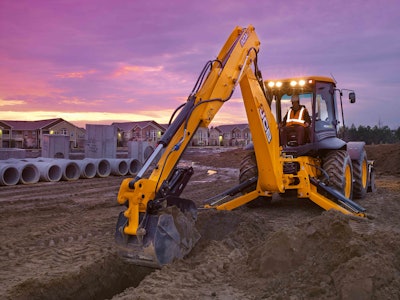
After an extended drop in sales, backhoes are recovering nicely.
New features have supported this recovery, as has a better understanding of what backhoes do well – and not so well.
Technology Catches Up
 The 695SV is one of two new side-shift backhoes from Case; the other is the 580SV. The 695SV is powered by an FPT engine rated at 110 gross horsepower mated to a powershift transmission with four forward and three reverse speeds. Maximum dig depth is 19 feet 7 inches, and operating weight is 22,245 pounds.Case CE
The 695SV is one of two new side-shift backhoes from Case; the other is the 580SV. The 695SV is powered by an FPT engine rated at 110 gross horsepower mated to a powershift transmission with four forward and three reverse speeds. Maximum dig depth is 19 feet 7 inches, and operating weight is 22,245 pounds.Case CE
Pilot control levers are being replaced by electrohydraulic joysticks. Versatile couplers are being included on both ends of the machine to make it easier to use attachments.
On the front, these attachments include 4-in-1 buckets, angle brooms and snow removal tools.
On the back are found the full array of compact excavator attachments. Compaction tools and hydraulic breakers are the most popular. Thumbs are gaining popularity, and extendable dipper sticks are available on several models.
Auxiliary hydraulics now have wider availability. Hydraulics and couplers can be spec’d from the factory on new machines, but many are also available as field install packages.
 The Cat 420 XE has a Cat C3.6 engine rated at 100 gross horsepower with no de-rating to 10,000 feet. All-wheel drive and powershift transmission are standard. Maximum operating weight is 24,251 pounds. Standard counterweight is 256 pounds; maximum counterweight is 1,014 pounds. Standard dig depth is 14 feet.Caterpillar
The Cat 420 XE has a Cat C3.6 engine rated at 100 gross horsepower with no de-rating to 10,000 feet. All-wheel drive and powershift transmission are standard. Maximum operating weight is 24,251 pounds. Standard counterweight is 256 pounds; maximum counterweight is 1,014 pounds. Standard dig depth is 14 feet.Caterpillar
Backhoe cabs, which have always been roomier and more comfortable than cabs on compact machines, are receiving more comfort features.
Telematics are becoming common on backhoes, and the fleet management advantages they offer are being expanded.
Yet to become prevalent on backhoes are 2D and 3D machine control.
Backhoe Strengths
 The 320 P-Tier from John Deere has a Deere PowerTech EWL 4.5L engine rated at 84 peak net horsepower and powershift transmission. Operating weight is 17,434 pounds. Dump height with the general-purpose bucket is 9 feet 1 inch, and dig depth is 14 feet 3 inches. Mechanical front-wheel drive is automatically disabled in fourth gear to reduce tire wear.John Deere
The 320 P-Tier from John Deere has a Deere PowerTech EWL 4.5L engine rated at 84 peak net horsepower and powershift transmission. Operating weight is 17,434 pounds. Dump height with the general-purpose bucket is 9 feet 1 inch, and dig depth is 14 feet 3 inches. Mechanical front-wheel drive is automatically disabled in fourth gear to reduce tire wear.John Deere
Being able to travel on the road has always been a key appeal for municipalities but also works well for site-development contractors. With typical speeds between 20 and 30 mph, backhoes can travel to the construction site and to nearby jobs. They eliminate the need to find room to park a trailer and tow-vehicle on site. Backhoes also have good maneuverability while traveling and while working.
The versatility comes from having two working ends that allow for loading, lifting, grading, trenching, placement and backfilling, plus the many other applications accessible with the use of the expanding list of attachments. Lift and breakout numbers for backhoes are in line with those for 8- to 9-ton compact excavators.
Backhoes are fully mature. Their repair, maintenance and operation are familiar to anyone who has been in the industry for any length of time.
Electrohydraulic joystick controls and assist functions such as return-to-dig make it easier for new operators to gain proficiency. The secondary market for backhoes is also well established, making resale easier.
 With an MSRP below $81,000 (see dealer for details), the Kubota M62 is among the value-oriented models on the market. Standard features include a 63-gross-horsepower engine, six-speed HST Plus transmission and ROPS/FOPS operator station. The M62 also has a rear PTO with 46 horsepower and 540 rpm and a rear three-point linkage for running tractor attachments.Kubota
With an MSRP below $81,000 (see dealer for details), the Kubota M62 is among the value-oriented models on the market. Standard features include a 63-gross-horsepower engine, six-speed HST Plus transmission and ROPS/FOPS operator station. The M62 also has a rear PTO with 46 horsepower and 540 rpm and a rear three-point linkage for running tractor attachments.Kubota
Backhoes’ locking differentials and four-wheel-drive options, plus ample ground clearance, offer excellent performance in poor ground conditions. The use of stabilizers with the front bucket on the ground provides levels of stability not seen in other machines, especially on uneven terrain. Buckets at both ends of the backhoe have greater capacity than is common on compact machines.
One of backhoes’ best attributes is value, which refutes the perception that they’re high-cost machines.
Up-front cost is higher – perhaps twice as high – compared to many compact machines. But backhoes generally have higher production and percentage of residual value, coupled with lower maintenance and repair costs and longer service life, than compact equipment.
The ability to use one machine offers further cost advantages, eliminating the need for two machines and two operators when opting for compact equipment, along with added savings by being able to road travel, rather than trailering, the backhoe to sites.
Backhoe Weaknesses
Backhoes are not the perfect machines for all applications. They have good maneuverability, but nowhere near that of counter-rotating skid steers and compact track loaders, which remain the preferred choice for severely confined worksites.
Similarly, while their capacities are greater than those of compact machines, they are less than those for dedicated loaders and excavators. The backhoe is a poor choice for production work. V-pattern loading, for example, is better left to a wheel loader. Backhoes may also take a back seat when it comes to spreading material and finish grading.
Trailering a backhoe demands more from the trailer and tow vehicle than trailering a single compact machine, or possibly even two compact machines, because of the backhoe’s weight and size.
Some of backhoes’ pros and cons depend upon the situation and the operator’s skills. Positioning the machine while trenching may be easier with a backhoe than an excavator – or not. The uncertainty of which machine is best can also be said regarding soil disruption and compaction.
In sum, backhoes are very good at many things but not the best at anything.
Expert Insight
 The New Holland B75D is designed as a cost-effective tool to serve multiple industries. The B75D has 75 gross horsepower with either a mechanical four-speed power shuttle or automatic PowerShift transmission. Operating weight is 17,457 pounds; lift capacity is 8,157 pounds, and maximum backhoe reach is 22 feet 1 inch. An optional LED package includes 10 lights for 360-degree illumination.New Holland
The New Holland B75D is designed as a cost-effective tool to serve multiple industries. The B75D has 75 gross horsepower with either a mechanical four-speed power shuttle or automatic PowerShift transmission. Operating weight is 17,457 pounds; lift capacity is 8,157 pounds, and maximum backhoe reach is 22 feet 1 inch. An optional LED package includes 10 lights for 360-degree illumination.New Holland
- James Gill, JCB product manager – “A backhoe is always a compromise. It is not the best mini excavator. It is not the best loader. You need the best backhoe, the one that is most versatile with the highest roading speed.”
- Doran Herritt, New Holland product manager – “New Holland and other OEMs are now offering value-oriented models that are smaller and have lower horsepower, such as our B75D. Customers who still think the acquisition cost of a backhoe is too high should revisit the market.”
- George MacIntyre, Case product manager – “There is a great deal of interest in electric-powered backhoe loaders, and the buying profile of key segments of the backhoe loader market match well with the electric backhoe. Case plans to introduce the 580EV electric backhoe to the North American market in the near future.”
- Emily Pagura, John Deere product marketing manager – “Consider that with a backhoe you can use one machine to unload pallets of pipe, dig the trench, place the pipe and backfill the trench. That’s just one of many examples of how a backhoe’s versatility increases utilization rates and reduces job costs.”
- Tyler Weyenberg, Kubota product manager – (Kubota uses the “term tractor loader backhoe,” or TLB, in keeping with the company’s focus on its tractor products.) “One neat offering about the Kubota lineup is the ability to remove the backhoe quickly and easily. These machines are equipped with a rear PTO and three-point linkage, which transforms the machine from backhoe loader to more of a traditional tractor that utilizes the rear PTO.”
- David Young, Caterpillar product application specialist – “Don’t overbuy. Our 416, for example, is available with 74 or 96 gross horsepower. The 74-horsepower model has the same performance on the backhoe and only slightly diminished performance when using the loader compared to the 96-horsepower model yet has a lower initial cost and simpler exhaust aftertreatment.”




